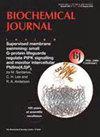比较分析犬和人的 HtrA2 以确定其在细胞凋亡和癌症中的作用
IF 4.4
3区 生物学
Q2 BIOCHEMISTRY & MOLECULAR BIOLOGY
引用次数: 0
摘要
在治疗方面,靶向促凋亡蛋白和抗凋亡蛋白一直是制定相关疾病防治策略的主要方法之一。人类高温所需的丝氨酸蛋白酶 A2(hHtrA2)可通过依赖和独立于 Caspase 的途径诱导细胞凋亡,与癌症、缺血性心脏病和神经变性等多种疾病有关,因此是一种很有前景的靶分子。近来,犬类模型在了解人类病理生理学方面的作用日益突出,而这些研究原本仅限于啮齿动物系统。此外,癌症研究中的犬类模型为研究自发性肿瘤提供了机会,因为与实验室啮齿类动物相比,犬类的体型、寿命和环境暴露明显更接近人类。因此,我们以 HtrA2 为模型蛋白进行了比较分析,以重新审视犬类可能是癌症研究的绝佳模型这一假设。我们进行了进化系统发育分析,结果证实犬类和人类的 HtrA2 关系密切。分子建模显示了结构上的相似性,包括催化三体残基的取向,随后进行的硅对接和分子动力学模拟研究确定了犬 HtrA2(ctrA2)的潜在相互作用伙伴。体外生物物理和蛋白酶研究表明,犬 HtrA2 与各自底物的相互作用具有相似性,在哺乳动物细胞培养中瞬时转染犬 HtrA2 会诱导细胞凋亡。因此,这项工作有望通过研究犬类自发性癌症模型系统为癌症研究开辟一条新途径。本文章由计算机程序翻译,如有差异,请以英文原文为准。
Comparative Analysis of Canine and Human HtrA2 to Delineate Its Role in Apoptosis and Cancer.
Therapeutically, targeting the pro- and anti-apoptotic proteins has been one of the major approaches behind devising strategies to combat associated diseases. Human high-temperature requirement serine protease A2 (hHtrA2), which induces apoptosis through both caspase-dependent and independent pathways is implicated in several diseases including cancer, ischemic heart diseases, and neurodegeneration, thus making it a promising target molecule. In the recent past, the canine model has gained prominence in the understanding of human pathophysiology that was otherwise limited to the rodent system. Moreover, canine models in cancer research provide an opportunity to study spontaneous tumors as their size, lifespan, and environmental exposure are significantly closer to that of humans compared to laboratory rodents. Therefore, using HtrA2 as a model protein, comparative analysis has been done to revisit the hypothesis that canines might be excellent models for cancer research. We have performed evolutionary phylogenetic analyses that confirm a close relationship between canine and human HtrA2s. Molecular modeling demonstrates structural similarities including orientation of the catalytic triad residues, followed by in silico docking and molecular dynamics simulation studies that identify the potential interacting partners for canine HtrA2 (cHtrA2). In vitro biophysical and protease studies depict similarities in interaction with their respective substrates as well as transient transfection of cHtrA2 in mammalian cell culture shows induction of apoptosis. This work, therefore, promises to open a new avenue in cancer research through the study of spontaneous cancer model systems in canines.
求助全文
通过发布文献求助,成功后即可免费获取论文全文。
去求助
来源期刊

Biochemical Journal
生物-生化与分子生物学
CiteScore
8.00
自引率
0.00%
发文量
255
审稿时长
1 months
期刊介绍:
Exploring the molecular mechanisms that underpin key biological processes, the Biochemical Journal is a leading bioscience journal publishing high-impact scientific research papers and reviews on the latest advances and new mechanistic concepts in the fields of biochemistry, cellular biosciences and molecular biology.
The Journal and its Editorial Board are committed to publishing work that provides a significant advance to current understanding or mechanistic insights; studies that go beyond observational work using in vitro and/or in vivo approaches are welcomed.
Painless publishing:
All papers undergo a rigorous peer review process; however, the Editorial Board is committed to ensuring that, if revisions are recommended, extra experiments not necessary to the paper will not be asked for.
Areas covered in the journal include:
Cell biology
Chemical biology
Energy processes
Gene expression and regulation
Mechanisms of disease
Metabolism
Molecular structure and function
Plant biology
Signalling
 求助内容:
求助内容: 应助结果提醒方式:
应助结果提醒方式:


